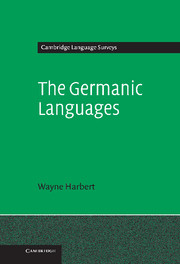Book contents
- Frontmatter
- Contents
- List of tables
- List of language abbreviations
- Acknowledgments
- 1 Introduction
- 2 The Germanic lexicon
- 3 The sound systems of Germanic: inventories, alternations and structures
- 4 The Germanic nominal system: paradigmatic and syntagmatic variation
- 5 The verbal systems of Germanic: paradigmatic and syntagmatic comparison
- 6 The syntax of the clause
- References
- Index
4 - The Germanic nominal system: paradigmatic and syntagmatic variation
Published online by Cambridge University Press: 06 July 2010
- Frontmatter
- Contents
- List of tables
- List of language abbreviations
- Acknowledgments
- 1 Introduction
- 2 The Germanic lexicon
- 3 The sound systems of Germanic: inventories, alternations and structures
- 4 The Germanic nominal system: paradigmatic and syntagmatic variation
- 5 The verbal systems of Germanic: paradigmatic and syntagmatic comparison
- 6 The syntax of the clause
- References
- Index
Summary
Nominal inflection
Historical prelude: Indo-European heritage and Germanic innovation
Affixes in GMC, as elsewhere, serve one of two functions. Derivational affixes are applied to derive new words. Thus, locate, relocate, relocation are distinct words, and each might be expected to be listed separately in a dictionary. On the other hand, locate, locates and located, distinguished from each other by inflectional affixes, are in an intuitively clear sense simply variant forms of the same word, and would accordingly not be listed separately in the dictionary. Derivational affixes were discussed briefly in Chapter 2. The paradigmatic and syntagmatic relationships among inflectional morphemes in the GMC languages (or their analytic equivalents – see below) will be treated in the next two chapters.
Synchronically, few typological generalizations can be made about the shape of inflectional morphology across the GMC languages, except that suffixes are by far the most frequent and productive type of inflection. This is in part a reflection of their IE heritage. Suffixes were the prevailing (though not the exclusive) device for signaling grammatical contrasts in IE as well. Inflectional prefixes are only marginally present in GMC (see Section 5.1.1), and infixes play no role in GMC (though IE had one). However, another type of word-internal inflectional morphology – replacives, in which one segment or string of segments within a root is replaced with another – is encountered quite frequently. Some GMC replacive morphemes – the ablaut patterns of strong verbs (sing, sang, sung) – are of IE origin.
- Type
- Chapter
- Information
- The Germanic Languages , pp. 89 - 269Publisher: Cambridge University PressPrint publication year: 2006

